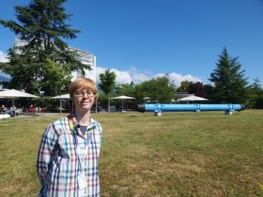A recent art exhibition in New York explored ways that quantum physics inspires graphic artists. Robert P Crease dropped in

“Other artists use oil paints or watercolour as media,” said Eric Heller, a professor of chemistry and physics at Harvard University who creates digital art based on his research. “I use quantum phenomena like resonance and branch flow.” He pointed to Random Sphere I – a painting of what looked like a golden globe covered by a dense tangle of darker lines, resembling the turbulent surface of the Sun. “Here my medium is a random wave.”
Heller and I were at the opening in December of “Art and the quantum moment” – a show held in the art gallery at the Simons Center for Geometry and Physics at Stony Brook University in New York. Curated by Lorraine Walsh, it was inspired by a book I co-authored with Alfred Scharff Goldhaber called The Quantum Moment: How Planck, Bohr, Einstein, and Heisenberg Taught Us to Love Uncertainty (Norton 2014). The book describes how and why the imagery and language of quantum mechanics went mainstream and came to influence art and culture.
Although Heller and the other two artists in the show – Frédérique Swist and Jacqueline Thomas – are not mentioned in the book, they each draw inspiration from quantum mechanics in different ways.
Eric Heller
Heller first got interested in photography when he was a graduate student at Harvard (1968–1973). He then started to paint as a professor at the University of California, Los Angeles, before mastering computer graphics while on sabbatical at Los Alamos National Laboratory in 1981. Heller’s artistic activity really took off, however, when he moved to the University of Washington in 1984 and began to graphically reimagine some of the phenomena he was examining (see www.ericjhellergallery.com).
“I was studying branch flow,” he told me, “or what happens when you launch a series of electrons from a single point at slightly different angles and let them flow over the equivalent of a bumpy floor.” Heller recalled that he started to play with the patterns graphically. He pointed to Transport XIII, which shows a dense set of differently coloured electron paths branching out from a point, juxtaposed with a random quantum wave on the surface of a sphere. The eerie result looks like a silver moon rising over a tangle of multicoloured threads.
We walked past Heller’s eight other works in the show. These, too, are graphical reimaginings of quantum phenomena he has studied. “I choose an image that I’ve found while playing around with the media,” he explained, “then finish it in Photoshop without making significant structural transformations to the original images.” However, Heller admits to being quite selective. “I’m very choosy. Some of these images would not work for me at all if the colour changed by 1%.” All his images nevertheless have science behind them. “I’m not a mathematical tourist,” he insists.
When I asked him what that meant, Heller drew a comparison. “It’s the difference,” he said, “between a tourist with a good camera taking a picture of some pretty piece of landscape and hanging it on the wall – and a geologist who is an expert in the landscape who recognizes that a particular formation illustrates a fundamental part of the region’s geology and is also pretty, taking a picture of that, and hanging it on the wall.”
Frédérique Swist
Frédérique Swist, senior designer at IOP Publishing, which publishes Physics World, contributed two works to the exhibit, and also came for the opening. Her work (fredswist.co.uk/gallery.html) often illustrates properties of wave interference, resonance, oscillations, and excitation functions. Swist says she often begins with technical graphs, then – unlike Heller – significantly transposes and reconstructs them.
One of her works on display was Excitable Waves (2010), which reinterprets the distribution of excitation functions in a study of biological cells adhering to physical surfaces. It was inspired by a figure in a paper published in the journal Physical Biology in 2009. “As I worked on it and added different lines and levels of colour,” Swist told me, “it acquired more layering and depth, and grew to become an image in its own right.”
Good Vibrations – Swist’s other piece in the show – was inspired by a project exploring the theme of affirmation and positivity that she was asked to join. In it Swist drew on her visual vocabulary of graphs and diagrams to produce a startling set of optical effects that she called a “visual rhythm”. Although depicted on a flat plane, the forms create a 3D effect of several superimposed planes that seem to vibrate, even expand and contract.
Jacqueline Thomas
A plinth in the gallery displayed two handmade, limited-edition books by British artist-designer Jacqueline Thomas from the Stanley Picker Gallery at Kingston University (www.jacquelinethomasbooks.co.uk). Equations (2005) and Constants (2006) consist of hand-sewn and hand-bound pages on which Thomas has created “digital collages”, fitting graphics with equations and spelled-out constants together in a puzzle-like fashion until the result looked right to her.
“I am fascinated by the knowledge that complex explanations can be simplified into a series of numbers and symbols,” Thomas told me. “As someone who recognizes the significance of the equations and constants, but without any real understanding, I can only respond to their beauty in visual terms. However, they were carefully selected by someone who understands and refers to the ‘beauty of mathematics’ – my astrophysicist daughter.”
The critical point
Classical mechanics has long had an impact on graphic arts, which persists to this day in the form of maps of self-similar systems associated with a relatively recent branch of mechanics, chaos theory. It is not surprising that the weirdness of quantum mechanics is also influencing graphic artists – be it Heller’s reimaginings of quantum phenomena, Swist’s transformations of representations of the incredibly precise and reproducible patterns, or Thomas’s collages based on the imagery of the language in which quantum language is expressed.



